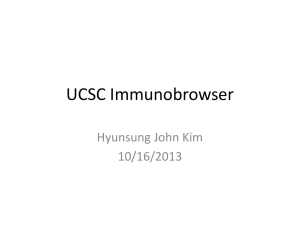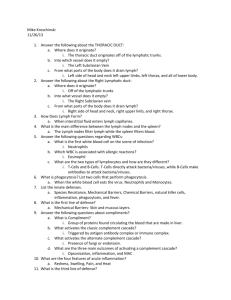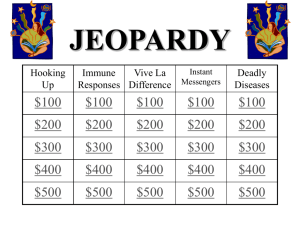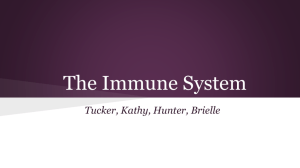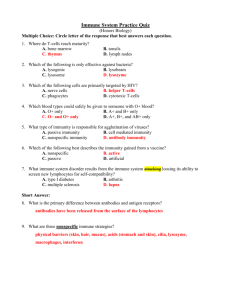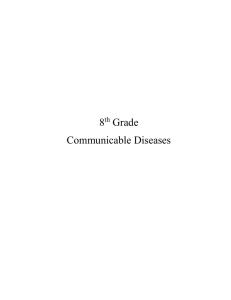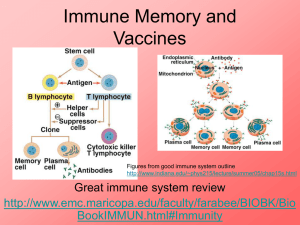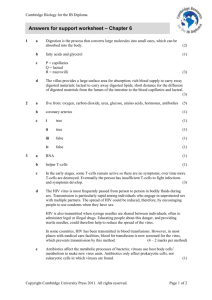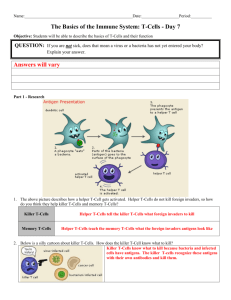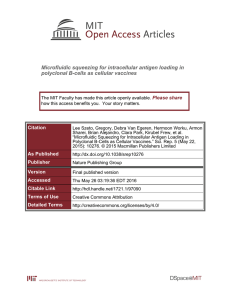Background information
advertisement
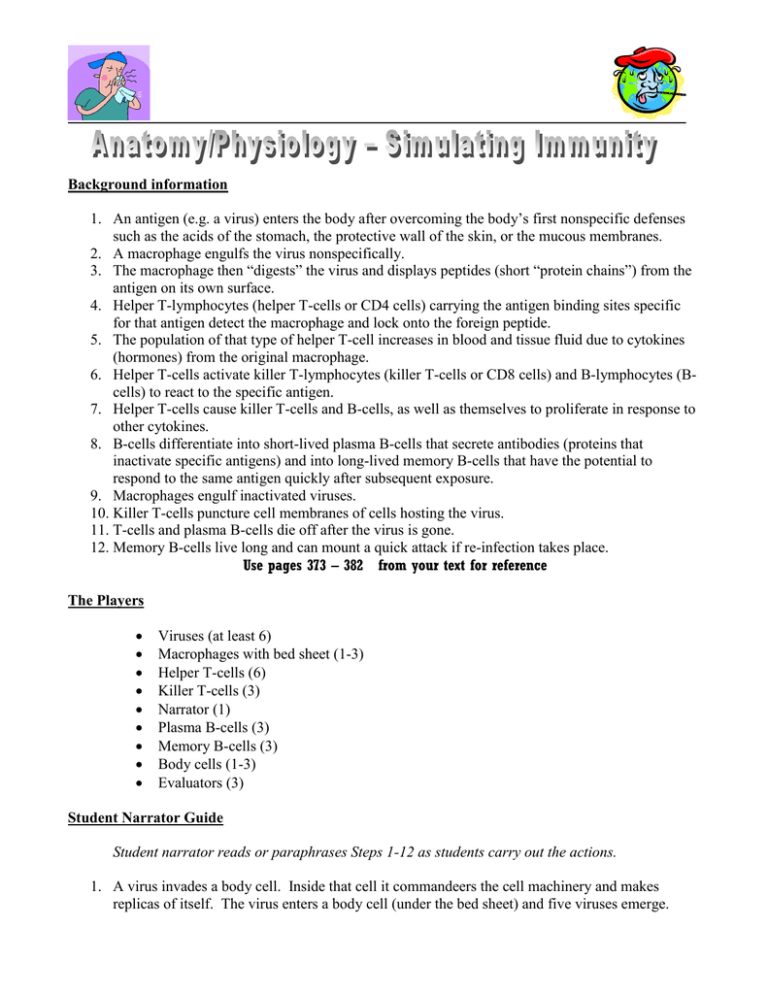
Background information 1. An antigen (e.g. a virus) enters the body after overcoming the body’s first nonspecific defenses such as the acids of the stomach, the protective wall of the skin, or the mucous membranes. 2. A macrophage engulfs the virus nonspecifically. 3. The macrophage then “digests” the virus and displays peptides (short “protein chains”) from the antigen on its own surface. 4. Helper T-lymphocytes (helper T-cells or CD4 cells) carrying the antigen binding sites specific for that antigen detect the macrophage and lock onto the foreign peptide. 5. The population of that type of helper T-cell increases in blood and tissue fluid due to cytokines (hormones) from the original macrophage. 6. Helper T-cells activate killer T-lymphocytes (killer T-cells or CD8 cells) and B-lymphocytes (Bcells) to react to the specific antigen. 7. Helper T-cells cause killer T-cells and B-cells, as well as themselves to proliferate in response to other cytokines. 8. B-cells differentiate into short-lived plasma B-cells that secrete antibodies (proteins that inactivate specific antigens) and into long-lived memory B-cells that have the potential to respond to the same antigen quickly after subsequent exposure. 9. Macrophages engulf inactivated viruses. 10. Killer T-cells puncture cell membranes of cells hosting the virus. 11. T-cells and plasma B-cells die off after the virus is gone. 12. Memory B-cells live long and can mount a quick attack if re-infection takes place. Use pages 373 – 382 from your text for reference The Players Viruses (at least 6) Macrophages with bed sheet (1-3) Helper T-cells (6) Killer T-cells (3) Narrator (1) Plasma B-cells (3) Memory B-cells (3) Body cells (1-3) Evaluators (3) Student Narrator Guide Student narrator reads or paraphrases Steps 1-12 as students carry out the actions. 1. A virus invades a body cell. Inside that cell it commandeers the cell machinery and makes replicas of itself. The virus enters a body cell (under the bed sheet) and five viruses emerge. 2. A macrophage engulfs a virus and “digests” it. The macrophage displays pieces of the antigen proteins on its surface. (Circle, polygon or square labels can be displayed.) 3. A helper T-cell detects this marker and recognizes that it is foreign. 4. The macrophage gives cytokines (candy) to the helper T-cell and it proliferates. 5. The helper T-cells give off cytokines (candy) that stimulate B-cells and killer T-cells to proliferate. 6. Helper T-cells also cause B-cells and killer T-cells to recognize the invading virus. (Narrator gives students copies of the antibody and killer T-cell receptors.) 7. B-cells differentiate to plasma and memory B-cells. 8. Plasma B-cells produce an antibody. The antibody matches the viral antigen and attaches to the viruses making them clump so that the macrophage can engulf them more easily. (Narrator handcuffs viruses and macrophage surrounds them with the sheet.) 9. Killer T-cells match the template with the viral antigen and kill the virus with toxins (water pistol). The virus dissolves. This step repeats until the last virus is killed. 10. Infection over, all the T-cells and B-cells die except for the memory B-cells. 11. Memory cells wait for more invaders. 12. A sixth virus with one of the original antigens comes on the scene. (What do memory B-cells do?) Questions for Review Answer in complete sentences. 1. Name at least three of the first lines of defense that viruses must penetrate in order to initiate the immune response. 2. How are macrophages different from T-cells and B-cells in the types of antigens to which they react? 3. What does the candy passed to the various cells represent? 4. What did the handcuffs represent? 5. How did the T-helper cells know that the body had been invaded? 6. What did the squirt guns represent? 7. What did the tape player on some B-cell labels represent? 8. Which cell types orchestrate the immune response? 9. How many types of viruses can one antibody disable? 10. Why do we keep immunity for a long time after an infection is over? 11. What stopped the immune activity? 12. What if the B-cells and T-cells didn’t die quickly? 13. Sometimes the immune system reacts to certain parts of the body as if it were foreign. What would happen if the immune system attacked the insulating myelin sheath around nerve cells in the central nervous system? 14. Name two other antigens besides viruses. 15. The AIDS virus attacks the helper T-cells. Explain how the immune response would be affected if these cells were in short supply. 16. Why is it said that people don’t die directly from AIDS?
